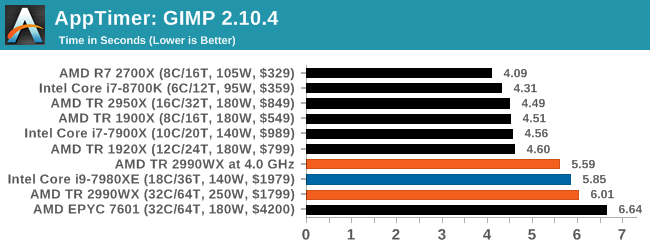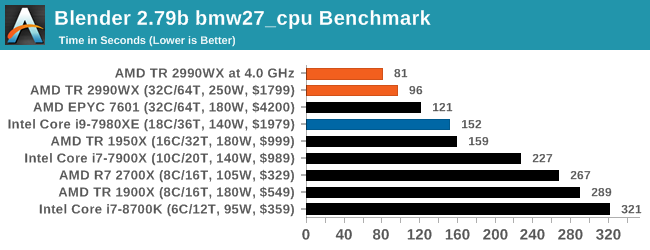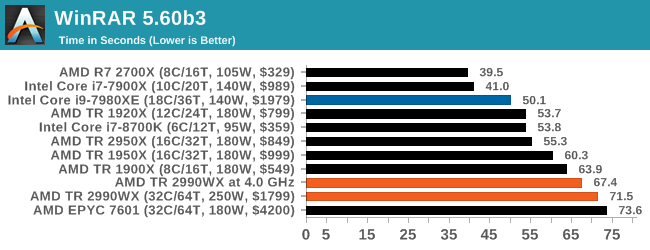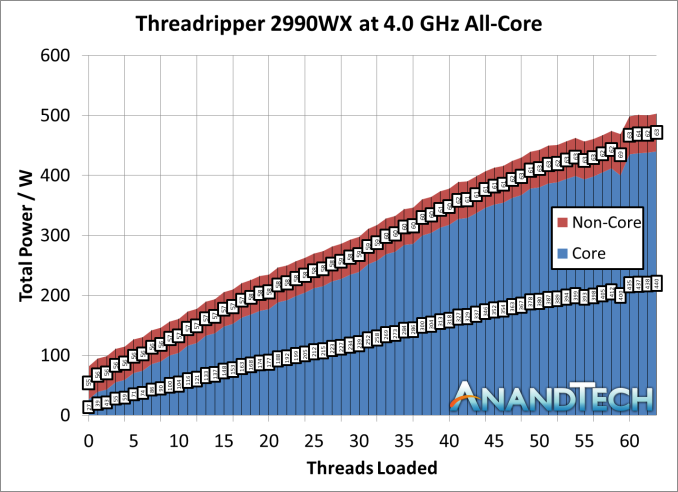The AMD Threadripper 2990WX 32-Core and 2950X 16-Core Review
by Dr. Ian Cutress on August 13, 2018 9:00 AM ESTOverclocking: 4.0 GHz for 500W
Who said that a 250W processor should not be overclocked? AMD prides itself as being a processor manufacturer that offers every consumer processor as a multiplier unlocked part, as well as using a soldered thermal interface material to assist with thermal dissipation performance. This 2990WX has an X in the same, so let the overclocking begin!
Actually, confession time. We did not have much time to do overclocking by any stretch. This processor has a 3.0 GHz base frequency and a 4.2 GHz turbo frequency, and in an air-conditioned room using the 500W Enermax Liqtech cooler, when running all cores under POV-Ray, we observed each core running around 3150 MHz, which is barely above the turbo frequency. The first thing I did was set the all-core turbo to 4.2 GHz, the same as the single core turbo frequency. That was a bust.
However, the next stage of my overclocking escapades surprised me. I set the CPU to a 40x multiplier in the BIOS, for 4.0 GHz on all the cores, all the time. I did not adjust the voltage, it was kept at auto, and I was leaving the ASUS motherboard to figure it out. Lo and behold, it performed flawlessly through our testing suite at 4.0 GHz. I was shocked.
All I did for this overclock was turn a setting from ‘auto’ to ‘40’, and it breezed through almost every test I threw at it. I say almost every test – our Prime95 power testing failed. But our POV-Ray power testing, which draws more power, worked. Every benchmark in the suite worked. Thermals were high (in the 70s), but the cooler could take it, and with good reason too.
At full load in our POV-Ray test, the processor was listed as consuming 500W. The cooler is rated for 500W. At one point we saw 511W. This was split between 440W for the cores (or 13.8W per core) and 63W for the non-core (IF, IO, IMC) which equates to only 12.5% of the full power consumption. It answers the question from our Infinity Fabric power page - if you want the interconnect to be less of the overall power draw, overclock!
We also tried 4.1 GHz, and that seemed to work as well, although we did not get a full benchmark run out of it before having to pack the system up. As stated above, 4.2 GHz was a no-go, even when increasing the voltage. With tweaking (and the right cooling), it could be possible. For anyone wanting to push here, chilled water might be the way to go.
Performance at 4.0 GHz
So if the all-core frequency was 3125 MHz, an overclock to 4000 MHz all-core should give a 28% performance increase, right? Here are some of the key tests from our suite.






Overclocking the 2990WX is a mixed bag, because of how it does really well in some tests, and how it still sits behind the 2950X in others due to the bi-modal nature of the cores. In the tests were it already wins, it pushes out a lot more: Blender is up 19% in throughput, POV-Ray is up 19%, 3DPM is up 19%. The other tests, is catches back up to the 2950X (Photoscan), or still lags behind (app loading, WinRAR).
Overclocking is not the cure-all for the performance issues on the 2990WX, but it certainly does help.











171 Comments
View All Comments
Lolimaster - Monday, August 13, 2018 - link
Then build one yourself.tmnvnbl - Monday, August 13, 2018 - link
How did you measure power numbers for core/uncore? Did these validate with e.g. wall measurements? The interconnect power study is very interesting, but I would like to see some more methodology there.seafellow - Monday, August 13, 2018 - link
I second the ask...how was measurement performed? How can we (the readers) have confidence in the numbers without an understanding of how the numbers were generated?GreenReaper - Wednesday, August 15, 2018 - link
Modern CPUs measure this themselves. AMD itself has boasted of the number of points at which they measure power usage throughout its new CPUs. Check out 'turbostat' in the 'linux-cpupower' package - or grab a copy of HWiNFO that will show it.Darty Sinchez - Monday, August 13, 2018 - link
This here article be awesome. I is so ready to buy. But, me no have enough money so I wait for it sale.perfmad - Monday, August 13, 2018 - link
So is the 2990WX bottlenecking in Handbrake because of the indirect memory access for some cores? Would be interesting to know if that bottleneck can be worked around by running multiple encodes simultaniously, The latest Vidcoder beta uses the handbrake core and has recently added support for multiple simultanous encodes. Would be really appreciated if you had time to look into that.Also do you share the source file and presets you use for the handbrake tests so we can run them on our hardware to get a comparison? My CPU isn't one you've tested.
Thanks for the review thus far.
AlexDaum - Monday, August 13, 2018 - link
I think, the problem with the memory bandwidth cannot be easily fixed, as it isn't a Problem, that one Process uses to much memory, but one core on one of the dies without memory controller, needs to access the infinity fabric to get Data. When all of the cores are active and want to fetch data from memory, it would cause contention on the IF Bus, which reduces the available memory bandwidth a whole lot and the core is just waiting for memory.This is just my speculation though, not based on facts, other than the bottleneck.
Aephe - Monday, August 13, 2018 - link
Those 2990WX Corona results! Can't wait to get a machine based on this baby! Holding up for TR2 release was worth it for me at least.Ian Cutress - Monday, August 13, 2018 - link
That benchmark result broke my graphing engine ! Had to start reporting it the millions.melgross - Monday, August 13, 2018 - link
It’s interesting. This reminds me of Bulldozer, where they made a bad bet with floating point (among some other things), and that held then back for years. This looks almost too specialized for most uses.